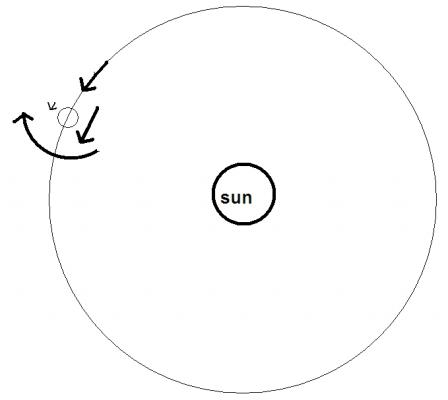-
Posts
6258 -
Joined
-
Last visited
-
Days Won
2
Content Type
Profiles
Forums
Events
Everything posted by michel123456
-
Show me evidence of a far away galaxy getting out of sight because of the expansion. Please explain why time is hyperbolic.
-
What does say the Copernican principle? It says that we cannot consider ourselves as privileged observers. You are in agreement with him except that Krauss said that there will be no evidence for the Big Bang. You mean "all observers at the same time stamp", not "all observers in the Universe". What you say is that an extraterrestrial astronomer on a galaxy 10 billion light-years away from us (that is about 10 billion years in the past) was not observing the same universe as we do today. And that some future astronomer will not see the same universe as we do today, that he will observe a single galaxy in an empty universe. I don't understand how it is possible to agree with such concepts.
-
I don't think so. Eminent cosmologist Lawrence Krauss explaing standard cosmology here answers some questions and says the following: Quote
-
That is not true. Common understanding says that we are able to discern the Big bang while future astronomers (in billion years from now) will not. In that way, we are privileged. IOW it means that we have swallowed that we are anywhere in space ( copernican principle) but we haven't swallowed yet that we are also "anywhere" in time. Because the common understanding states that we are not "anywhere" but at a very specific location in time. IMHO it must be wrong. We must be anywhere both in space and in time.
-
I know it is the standard point of vue. But I really wonder why scientists are comfortable with that idea. To me it is monstrous, it should ring a bell because, as far as I can understand, it violates the copernican principle since it makes us today privileged observers of the universe.
-
Mmmm. My opinion is that nobody so far has a good understanding of Time. That Space & Time would be relative, I think it is a well established fact. Space & Time are relative. That Space & Time would be emergent phenomena, yes that would be great, but I don't see why that would made both Space & time "illusions". And finally, IMHO philosophy does not possess a good grasp upon Space & Time. Physics have surpassed philosophy in all weirdness, by far.
-
-

IS IT GRAVITY THE MAIN SOURCE OF MOVEMENT? MAY BE THE ONLY?
michel123456 replied to Kramer's topic in Speculations
Maybe I misinterpreted Ophiolite's post Sure. If the law applies to Venus, then it must apply to all planets, Earth included. But I am not interested to support Kramer's idea any further. -

IS IT GRAVITY THE MAIN SOURCE OF MOVEMENT? MAY BE THE ONLY?
michel123456 replied to Kramer's topic in Speculations
Yes. Maybe Kramer found why Venus is rotating that way and why Earth's rotation is slowing down. Who knows? Note: I don't know. -

IS IT GRAVITY THE MAIN SOURCE OF MOVEMENT? MAY BE THE ONLY?
michel123456 replied to Kramer's topic in Speculations
Kramer is not stupid. -

IS IT GRAVITY THE MAIN SOURCE OF MOVEMENT? MAY BE THE ONLY?
michel123456 replied to Kramer's topic in Speculations
Well, if the analogy is correct, the car will turn in direction if the tire that stays behind. That means: observing the solar system from above, the Earth orbits counter-clockwise. The part at night should then go slower, and thus I understand that the Earth should spin on its axis clockwise. Isn't it the correct way to see things following your idea? See sketch below -
Yes. We don't disagree. If one day they find a star twice the age of the universe, they will be some concern about the method for finding the age. You (I mean I) will have to wait longer before discussing the BB.
-
I've seen that before. No tricky video. But I must admit I understand nothing. Even after watching this
-

Designing a building based on demand and occupancy
michel123456 replied to cholical's topic in Engineering
I am not an expert in airports. You could find some Architect with experience in that field. But it will get very complicated, an airport terminal is a very complex building and designers are very specialized, not always willing to spread their knowledge. The know-How is a precious thing. You can find info on the Net about existing airports. I found for Heathrow here. You can also look for case studies. I'd suggest not to make your project too detailed, you'll get lost. An implatation plan is already quite complicated. Put the runway (1 or 2), the terminal emplacement, the control tower emplacement, the helicopter pads,the roads, highways trains, the parking areas, the hotel(s), eventually the retail park, etc. Simply to make a list of functionalities is a difficult task. _airport offices, restaurants for the staff, police departments, fire service buildings, repair departments, stock, refueling, and so many others,shopping mall, hotel, even churches. Get a list first. Take the figures from existing ones. I found this case study about Athens airport, with very few usuable info. http://ardent.mit.edu/airports/ASP_current_lectures/ASP%2007/Athens%2007%20v2.pdf ---------------------- edit and these numbers about peak. http://www.aia.gr/company-and-business/press-and-Media/press-office/press-releases/athens-international-airport-handles-efficiently-the-olympic-departures-peak-of-august-30th-2004 -

IS IT GRAVITY THE MAIN SOURCE OF MOVEMENT? MAY BE THE ONLY?
michel123456 replied to Kramer's topic in Speculations
Supporting endercreeper01, I don't understand Swansont's point. Is Kramer right or wrong? -

Question about relation acceleration en special relativity
michel123456 replied to Rettich's topic in Relativity
The bold part is the thing I cannot understand (or do not want to understand, in all honesty). To me everything must be symmetrical: what you build can be unbuild. What you gain must be lost. I don't understand how some effect becomes one-way. It becomes paradoxal. -

IS IT GRAVITY THE MAIN SOURCE OF MOVEMENT? MAY BE THE ONLY?
michel123456 replied to Kramer's topic in Speculations
He must have been influenced by Julius Caesar who most probably used servants ghostwriters who couldn't use the profanity of speaking in the 1st person as if they were the emperor. Have you deciphered Kramer's post? From what i understand, he says that a point on a small radius from the Sun have faster orbital velocity than a point on a larger radius. Which is exactly what Keppler's law says. And he says that it is the reason why the planets are spinning on their axis. Because a point on Earth facing the Sun has a larger orbital velocity than a point at night. IMHO it must be wrong: the difference in orbital velocities between the 2 points must cancel out and produce no rotational momentum at all. -
I was expecting your post much earlier Pan. My humble opinion is that all scientists who observe that kind of stars are hardly trying to fit their observations with the standard model of cosmology because it is risky. It is so easy to introduce a plus-minus error margin that fits. We will have to wait till some outrageous measurements are made, repeated several times by many institutions, before seriously questioning the model. I am sure this will happen. Yes.
-

Question about relation acceleration en special relativity
michel123456 replied to Rettich's topic in Relativity
The astronaut in the accelerating rocket can constantly have the same thrust all the time. The astronaut will never feel any "relativistic force" that will prevent him to send his super-fuel to the thrusters, nor will he feel the rocket getting heavier because of a relativistic mass increase. For him things will remain exactly as usual. The only thing is that all observers at rest will observe him gaining mass and accelerating less and less. I suppose that the astronaut in the rocket, looking through the window at the planet he started from will observe the planet accelerating less and less, and gaining mass. Otherwise I suppose the rest of the universe will look as usual. After a hundred years, I still miss what would be the ending observation from the observer at rest at the launch pad. -
Here in Greece all photons are GR
-
Yes, that helps to find x3 (I made an approach with abcde, finding c) But i still miss imatfaal's next steps.(though he seems to get it right). ? x3 = x4-1 ? ? x3 = x2+2 ?
-
What is the difference with a slit? Isn't a slit also a "hole in a barrier"? (edit) i don't expect that to make any change in the experiment. (edit#2) Especially if the pipe is wide enough and does not touch the laser beam. I thought that light follows a straight line. (Sorry, a geodesic)
-
O.K. Even in the case it goes through both slits, did he change direction or not?
-
I can find x3 but where do x3 = x4-1 come from? --------------- (edit) otherwise I get the same result.



